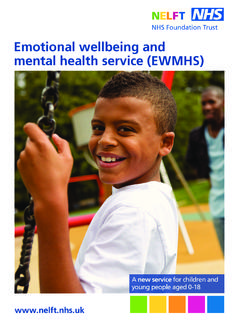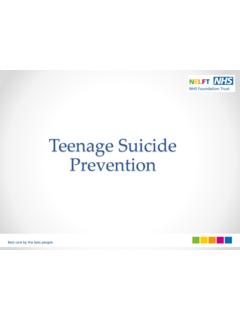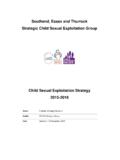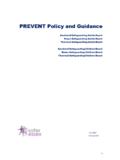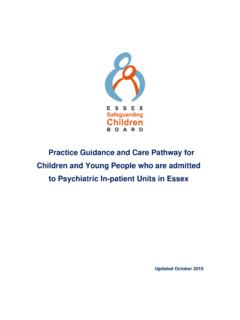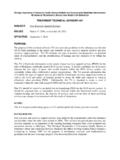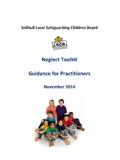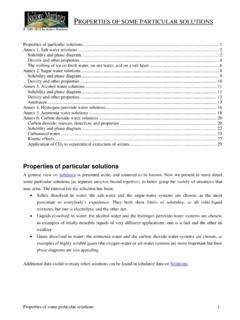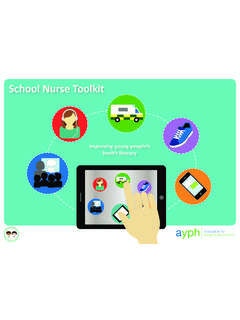Transcription of Neglect Multi-Agency Practice Guidance
1 1 Neglect Multi-Agency Practice Guidance For those working with children, young people and families in Essex Status Version 1 Author ESCB Policy & Procedure Sub-committee Date March 2017 2 Contents Page 1. Introduction 3 2. Definitions and Types of Child Neglect 4 3. Recognising Signs and Indicators of Child Neglect 7 4. Risk and Protective Factors Associated with Child Neglect 8 5. Neglect and Significant Harm 14 6. Effects of Neglect 14 7. Learning from Serious Case Reviews 16 8. Assessment of Child Neglect 18 9. Chronologies 23 10. Working with Resistance 25 11. Supervision 28 12. References, Further Reading & Resources 30 13. Appendix 1: Assessment of parental motivation to change 32 14. Appendix 2: Chronology template 36 3 Child Neglect is the most pervasive form of child abuse in the UK today.
2 It robs children of the childhood they deserve that is their right and leaves broken families, dashed aspirations and misery in its wake. And, while we know more about the causes and consequences of Neglect than ever before, it remains the biggest reason for a child to need protection. As a society, it is in our power to change this . Action for Children, 2010 Definition of child or young person A child is anyone who has not yet reached their 18th birthday. Children therefore means children and young people throughout. The fact that a child has reached 16 years of age, is living independently or is in further education, is a member of the armed forces, is in hospital or in custody in the secure estate for children and young people, does not change his or her status or entitlement to services or protection under the Children Act 1989 . (See Children s Act 2004) 1.
3 Introduction Awareness of child Neglect and its consequences on the future well-being and development of children has increased during the last two decades. It is notoriously difficult to define and varies by type, severity and persistence. Research shows that it often co-exists with other forms of abuse and adversity. To make the management of Neglect even more complex, numerous reviews have commented on the dynamics of professional uncertainty regarding thresholds and criteria and what constitutes significant harm. Thus, Neglect can lead to a difference of opinion and professional optimism in relation to good enough care . Neglect is the most common reason for child protection plans in the United Kingdom. Analysis of Serious Case Reviews has made the link between Neglect and childhood fatalities. Apart from being potentially fatal, Neglect causes great distress to children and leads to poor outcomes in the short and long-term.
4 Consequences can include an array of health and mental health problems, difficulties in forming attachment and relationships, lower educational achievements, an increased risk of substance misuse, higher risk of experiencing abuse as well as difficulties in assuming parenting responsibilities later on in life. The degree to which children are affected during their childhood and later in adulthood depends on the type, severity and frequency of the maltreatment and on what support mechanisms and coping strategies were available to the child. This document (adapted from Solihull LSCB Neglect Toolkit) contains Guidance designed for Multi-Agency managers and all those working with children and their 4 families to support their understanding, identification, assessment and interventions in childhood Neglect . This includes helping you to consider at an early point, the likelihood of the parent s capacity for change, which needs to be made on the basis of timely outcomes for the child.
5 2. Definitions and Types of Child Neglect Neglect is the persistent failure to meet a child s basic physical and/or psychological needs, likely to result in the serious impairment of the child s health or development . Neglect may occur during pregnancy as a result of maternal substance abuse. Once a child is born, Neglect may involve a parent or carer failing to: Provide adequate food, clothing and shelter (including exclusion from home or abandonment) Protect a child from physical and emotional harm or danger Ensure adequate supervision (including the use of inadequate care-givers) Ensure access to appropriate medical care or treatment. It may also include Neglect of, or unresponsiveness to, a child s basic emotional needs. HM Government Working Together to Safeguard Children: a guide to inter- agency working to safeguard and promote the welfare of children , 2015.
6 This is the official Government definition of Neglect and is important as it supports a consistent understanding of Neglect amongst Multi-Agency partners. It provides a guide and a threshold in the identification, assessment and decision-making process of Neglect and is the criteria for determining if a child is subject to a child protection plan. However, the definition can only be useful if there is a clear and shared understanding of Neglect and its impact upon a child s health and development - in its broadest sense. Neglect , (in contrast to other forms of abuse where specific and critical incidents can highlight significant harm) often presents us with less tangible and more diverse indicators which makes it harder to identify. Further, differences of opinion about what constitutes persistent failure , serious impairment of health or development and adequate make this definition, as with others, more open to interpretation; resulting in confusion and lack of consensus amongst those working with children and their families about what Neglect actually involves.
7 An additional difficulty that those working with children and families may have in identifying Neglect relates to concerns about imposing their own standards and values on other people and a reluctance to be judgemental. Yet those working with children and families are tasked to make professional judgements based on the 5 best evidence available and within a co-ordinated Multi-Agency response. The definitions of Neglect , an understanding of the impact upon the child s health and development and effective working together can help those working with them to distinguish between being judgemental and articulating a defensible professional judgement . In seeking to clarify Neglect further, some areas to consider are: a. Persistence: Neglect is usually but not always - something that is persistent, cumulative and occurs over time. It can continue without a critical event, or incidents may be widely spaced, but its effects are corrosive to children s development.
8 Its presentation as a chronic condition requires the collation and analysis of sometimes small and seemingly insignificant events that only when viewed together provide evidence that Neglect is an issue of concern. Gardener (2008) warns of the danger of viewing Neglect as a chronic phenomenon as this involves waiting for a time when chronic is deemed to be present this delays professional response to children s safeguarding needs. Neglect can also occur as a one-off event where there is a family crisis or a parent is under the influence of drink/drugs. It is possible that one-off incidents are part of a wider background of the Neglect of the child, thus any incident-based reports need to be assessed to identify whether there are patterns, however widely spaced. b. Acts of Omission and Acts of Commission: Neglect is often but not always - a passive form of abuse and the definition from Working Together 2015), refers to failures to undertake important parenting tasks, what is often referred to as acts of omission.
9 It is not always easy to distinguish between acts of omission and acts of commission however and both can occur simultaneously. For example, a parent leaving a child in the supervision of an unsuitable person involves both an omission to provide appropriate supervision and intent in leaving the child with someone unsuitable. The issue for those identifying and assessing Neglect is less about understanding intent and more about assessing the child s needs not being met, and whether the parent has the capacity to change. Neglect may be passive, but it is nevertheless harmful. c. Neglect often co-exists with other forms of abuse: Certainly, emotional abuse is a fundamental aspect of children s experiences of Neglect . However other forms of harm such as physical abuse, sexual abuse, harm from exposure to domestic abuse, child sexual exploitation can and do co-exist with Neglect .
10 The existence of Neglect should alert those working with children and families to explore if children are being exposed to other forms of harm. 6 d. Parents and carers with complex and multiple needs: A wide range of circumstances and stressors exist for parents whose children are neglected including poor housing, poverty, lack of capacity or knowledge about children s needs, disability, learning impairment, asylum or refugee status and other circumstances which might weaken parental capacity. Brandon (2012), in a review of serious cases involving child deaths, collectively called parental substance and/or alcohol misuse, domestic abuse and mental health difficulties the toxic trio . These have been identified as common features of families where harm to children has occurred. They are viewed as indicators of increased risk of harm to children and young people.
